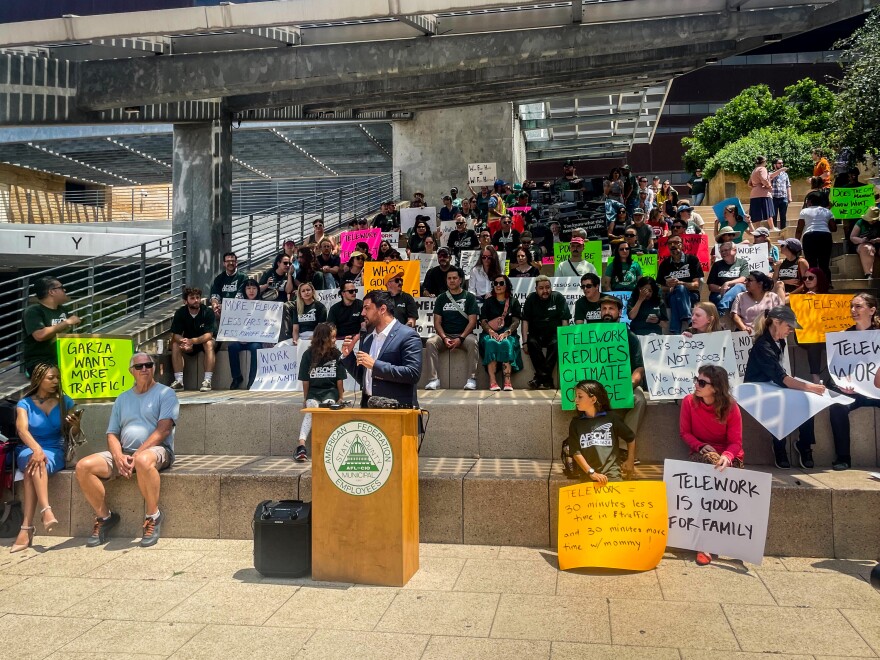Renue Jones got comfortable working from home during the pandemic. Living 50 miles outside the city, it has also saved her a lot of time and money.
Jones said she's more productive, and her job as a contract specialist with Austin Public Health isn’t front-facing, meaning she doesn’t deal with clients face-to-face.
“If you were to call my agencies, any one of them, and ask them if I continue to give them good service, and continue to take care of them on a daily basis working from home, I guarantee they’d all tell you yes,” Jones said. “Because I am more responsive working from home and getting to their emails than I am at the office.”
So she was disturbed when interim City Manager Jesús Garza said employees like her would have to come into the office at least three days a week. Managers would have to be in person all week.
"It is imperative, in my opinion, that we work to ensure the public’s trust," he wrote in a memo over the summer. "We cannot completely do so if we are not present or responsive to their needs. With this in mind, we must address the various department policies surrounding telework.”
Garza argued it was hard to establish and maintain consistency and reliability without a uniform set of rules across all city departments. The new work policy was originally set to go into effect in October, but staff pushed back.
A desire for flexibility
Dozens of city workers rallied in front of City Hall over the summer, saying the policy disrupted the life-work balance they became accustomed to. Many said the change would significantly increase costs for child care and commuting.
“We want to ensure the City of Austin remains competitive in the workforce, and part of what the City of Austin can offer is that flexibility.”Council Member Vanessa Fuentes
“For those of us that have been working telework for the last almost four years and been extremely efficient with serving our community and our agencies, why is it so important for them to have us back in the office?” Jones said.
Since then, the local chapter of the American Federation of State, County and Municipal Employees, which represents city employees, has been working with Garza to find a middle ground.
Council Member Vanessa Fuentes helped lead the effort to allow telework, highlighting not only the climate impact of commuting, but also the impact these changes could have on working families.
“What we heard from city workers is that they wanted to maintain flexibility,” Fuentes said. “We want to ensure the City of Austin remains competitive in the workforce, and part of what the City of Austin can offer is that flexibility.”
Some movement
Carol Guthrie, business manager for AFSCME local 1624, says the union was able to move Garza a little.
Instead of three days per week, many employees will now be required to go in at least 50% of the time over a two-week period, or five days over that time. That is one day fewer than what was originally proposed.
Austin employs more than 14,000 employees, and Guthrie says about 52% of them are eligible for telework. But some will be able to exercise that option more than others.
According to city data, nearly 7,000 workers — including those in public safety jobs, executive-level positions and front-line employees who work in animal services and public works — will not be able to telework at all. About 2,000 employees — in IT and call center jobs — will be able to work from home 80% to 100% of the time, and all other eligible staff can work the 50% schedule.
Guthrie said employees can petition to an outside committee for an exemption to the policy if they want more flexibility.
“That exemption process is really critical,” she said. “So, I think [after that process] we will have a good amount of people who will continue to telework, especially those recently hired or were hired with telework.”
Will that be enough?
Jones said many of her colleagues have quit knowing the change was coming.
Whitney Holt was one of them. Holt worked with the City of Austin for two years and was going into the office once a week.
She said she worked better and more comfortably from home, and felt adding two more days in the office was unnecessary. She found a job working in health equity with Travis County's Health and Human Services, where she can work from home as much as she likes.
“I had planned to retire with Austin,” Holt said. “But this was the deal breaker for me.”
She said the department she worked for was a little more flexible on work-from-home policies and allowed up to three days of telework before the pandemic.
“So, for a lot of folks we actually have less telework than we did before the pandemic,” Holt said.
Guthrie said the union is working to get as many people exempt as possible, but that it will take some time. Jones hopes it's quick enough to retain the hundreds of good employees who work for the city.
"I just wish that the leaders would really take into consideration the value of their staff," she said. "Despite all the adversity we've faced over the last few years, everyone has stepped up to make sure the community didn't suffer."
Jones, who applied for an exemption, said she is allowed to keep her current telework schedule until her case is ruled on.






